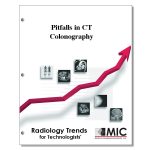

Pitfalls in CT Colonography
An overview of the pitfalls of both 2D and 3D CT images in CT colonography.
Course ID: Q00193 Category: Radiology Trends for Technologists Modalities: CT, Radiography3.25 |
For CT Technologists |
Satisfaction Guarantee |
$34.00
- Targeted CE
- Outline
- Objectives
Targeted CE per ARRT’s Discipline, Category, and Subcategory classification for enrollments starting after February 8, 2023:
[Note: Discipline-specific Targeted CE credits may be less than the total Category A credits approved for this course.]
Computed Tomography: 3.25
Procedures: 3.25
Abdomen and Pelvis: 3.25
Registered Radiologist Assistant: 2.25
Procedures: 2.25
Abdominal Section: 2.25
Outline
- Introduction
- CT Colonographic Technique
- Technical Errors
- Patient Preparation
- Stool
- Residual Fluid
- Distention
- Underdistention
- Spasm
- Perforation
- Scanning
- Artifacts
- Stair-Step Artifacts
- Image Noise
- Patient Preparation
- Pitfalls in Evaluation
- Evaluation Technique
- Values for 2D Imaging
- Three-dimensional Shine-Through Artifacts
- Three-dimensional Rendering
- Perception Errors
- Technique
- Underdistention
- Residual Fluid
- Blind Spots
- Interpretation Errors
- Content
- Intrinsic Lesions
- Extrinsic Lesions
- Computer-aided Detection
- Evaluation Technique
- Conclusions
Objectives
Upon completion of this course, students will:
- be able to identify the pitfalls of MDCT in CT colonography
- understand how haustral folds interfere with CT colonography evaluation
- list factors affecting the diagnostic sensitivity in CT colonography
- know advantages of MDCT scanners over single-row detector scanners in CT colonography
- comprehend the effect of image noise on CT colonography evaluation
- have learned essential patient preparation for CT colonography
- understand how gas is used to distend colonic segments
- understand the importance of acquiring images in both prone and supine positions
- be able to identify different artifacts in CT colon images
- understand indications for oral vs. intravenous contrast administration in CT colonography
- know how to interpret residual stool in the bowel on CT images
- know how to detect residual stool in the bowel on CT images
- know how to detect residual fluid
- recognize differences in prone vs. supine CT images of the colon
- learn about the effect of gravity on sensitivity and specificity
- know characteristics of colonic segments
- recognize the consequences of underdistention
- know how to differentiate spasms from a collapsed colonic segment
- be able to identify colonic wall perforations
- recognize the effect of respiratory artifacts in CT colonography
- understand the cause and appearance of the stair-step artifact
- know how to differentiate image noise from IBD
- comprehend dose considerations in CT colonography
- learn about the effects of metal artifacts in CT colonography
- understand the usefulness of a wide window setting in CT colonography
- understand the usefulness of a narrow window setting in CT colonography
- know how to detect a polyp
- understand the advantages and pitfalls of the “fly through” technique
- know how to evaluate 2D planar and 3D reconstructed images of the colon
- learn the pitfalls of underdistention of the colon and how to minimize them
- learn the pitfalls of residual fluid of the colon and how to minimize them
- know how to identify blind spots and overcome their pitfalls
- learn how to characterize a polyp
- know how to characterize residual stool and fecal-impacted diverticula
- know how to identify and characterize gas bubbles in the colonic lumen
- know how to differentiate stenosis from a collapsed colonic segment
- comprehend the importance of evaluating both 2D planar and 3D surface reconstructions
- be familiar with detection and interpretation of diverticula
- identify intrinsic vs. extrinsic lesions
- understand the utility of CAD in CT colonography
